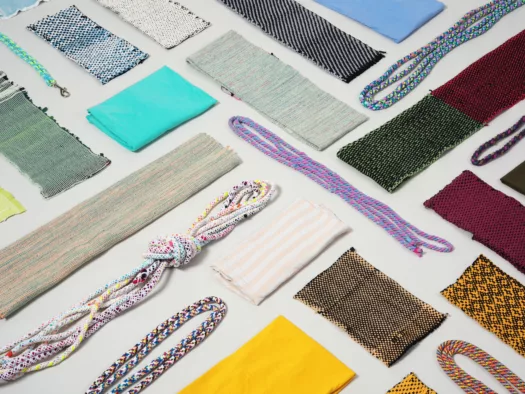
Ideas from the weißensee academy of art berlin
New Clothing Fit for the Future
Buy – wear – discard. All too often, this is the fate of many products of our time. Textiles, especially, in this regard, have a huge impact on the climate and the environment. Students in the Textile and Material Design programme at weißensee academy of art berlin have been thinking about how to go about changing this.

Let’s be honest: how many items of clothing have you bought recently? If the figure is four or five in the last month, then you’re spot-on average. That adds up to around 60 pieces of clothing a year. Quite a lot, isn’t it?
No wonder the production of textiles has such serious consequences. According to an analysis by the European Environment Agency in 2022, each person in Europe annually uses up around 156 kilos of raw materials, 25,600 litres of water (surface, ground and rain water) and 172 square metres of land for clothing alone – shoes and household textiles not included. And not to mention the vast quantities of greenhouse gases emitted and the barely justifiable circumstances in which workers in the supply chains find themselves. And then those chic trousers that didn’t quite make it into the ranks of your favourites end up forgotten at the bottom of the wardrobe.
So it’s high time we considered other options. Initial initiatives, especially by smaller labels, have involved switching to more environmentally friendly production methods and fairly produced materials. Innovations and solutions are being developed, in particular, at universities and institutes – for instance, at Weißensee Academy of Art Berlin. Seven projects from the Textile and Material Design programme are showing how things could work in the future – suggestions for innovative foils and packaging materials included.
Rainproof in algae
Malu Lückung asked herself what would happen if we were to make a virtue out of necessity. The textile industry’s chemical residues – from the dyeing process among other things – often end up in the water and destroy the ecological balance, leading to the uncontrolled growth of algae. However, the algae can be put to good use. As part of the “Cladophora” project, the algae of the same name are harvested from Berlin’s lakes and rivers and processed into fabrics and biodegradable plastic. The chic coat created from the material is not only suitable for the catwalk, but also keeps its wearer dry in the rain.
Dressed up in fruit peel
Why throw something away if it can still be used? In her “Peelsphere” project, Youyang Song uses fruit waste such as banana or orange peels. She produces material that can be further processed, printed on and embroidered. Even the surface structure can be shaped. The material is also fully recyclable – meaning, it can be reused as often as required.
Well packaged
Algae are the ideal base material to create something new. Juni Sun Neyenhuys produces packaging materials from brown algae that decompose without leaving any residue after use. In this way, her project titled “Mujō” creates a circular system and ensures that today’s packaging doesn’t become tomorrow’s waste. The decisive advantage held by this raw material: brown algae grow on their own in the sea, so they don’t have to be specially cultivated. They also produce oxygen and clean the oceans.
The apple’s core
Like Youyang Song, Verena Brom’s project is based on fruit residues. For “A Matter of Fruit”, she uses plant residues, so-called pomace, left over from the industrial production of fruit juices. Apple juice alone produces 200,000 tons of pomace in Germany. An abundance of raw material available for use! For instance, for biodegradable foils – that are a convincing alternative in terms of look and feel to their petroleum-based counterparts. And these innovative foils can even be printed on and used as fabric for sewing!
Colour tops intoxication
What would life be like without colour? All the same, artificial colourants, in particular, are often toxic, carcinogenic and harmful to the environment. In a nutshell: they’re a problem. So new colours are needed. As part of their project named “MycoColors”, Birke Weber and Friederike Hoberg are researching how to dye textiles with fungi. You won’t get high from wearing the clothes, but the rush of colour is definitely promising. Whether bright yellow or blood red – mushroom dyes are a vibrant alternative to conventional colourants.
Down to the last thread
In her project “Restless Textiles”, Lobke Beckfeld recycles fibre remnants from textile production. For this purpose, she tests fibres in experiments and then processes them using various techniques to create a wide range of high-quality materials. Residues become valuable raw materials, extending the useful life of textiles by a factor of up to three. Now that’s what you call chic!
Turning old into new
“Urban Fibers” by Tau Pibernat and Vera Castelijns produces yarns from discarded cotton clothing. The project aims to establish a local textile production that is both sustainable and environmentally friendly. The yarns are adapted to the locally available weaving, knitting and braiding machines, which makes them easy-to-use for local textile producers. And since the yarns aren’t dyed, the environmental impact is minimised – and the production process is even less complicated.
